
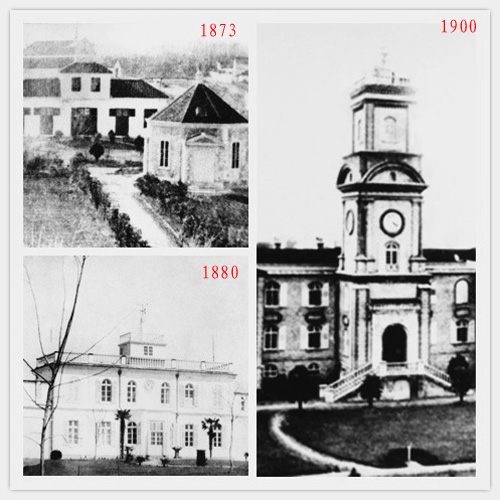
Xujiahui Observatory in 1873、1880 and 1900.

Xujiahui Observatory: the centennial weather station in nowadays.
Shanghai Xujiahui Observatory, a multi-functional observatory was established in 1872. It has been called “the No.1 meteorological observatory in the Far East” at that time and has played a significant role in the international meteorological history. Xujiahui Observatory also has been highly praised by the international community.

Sounding ballon.
Shanghai Xujiahui Observatory witnessed the Chinese modern meteorological history. It gives us lots of precious data such as the meteorological building with history of over 100 years and the unique style. Its scientific and cultural values are of great importance. Xujiahui Observatory started to observe weather from December, 1872. In 1879, it issued typhoon forecast for the 1st time. In 1882, it released weather forecast in both Chinese and English newspaper which included not only Chinese meteorological report, but also report for northern and southwestern Asia. In 1884, the signal tower in the bund in Shanghai was built. In 1895, China's 1st surface weather map for East Asia was produced there. In the end of the 19th century, its contact network reached Siberia in the north, Manila in the south, Japan in the east and India Peninsular in the west. Meanwhile, Xujiahui Observatory also released weather information for the meteorological observatories in Chinese coastal areas and sailing ships and gained gratefulness of navigators for the meteorological report. From March 1 of 1920, after releasing daily weather report by radio, Xujiahui Observatory started to release upper air conditions at 11:00 and 17:00 every day.

Summer and winter Pavilion.

barometer
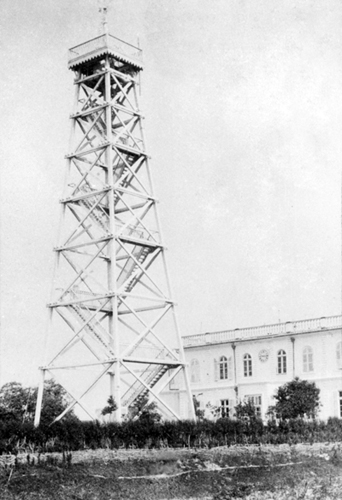
Berkeley wind instrument.

The record of temperature and humidity in 1865.
At the beginning of the 20th century, the Xujiahui Observatory has gradually become an integrated research institution, which included meteorological, astronomical, geomagnetic and marine services. In addition, as one of the world's three major reference measuring points, the Xujiahui Observatory once participated in the international Longitude joint-measurement in 1926 and 1933. Witnessed two world wars and the war of liberation, the Xujiahui Observatory has continued to observe without interruption, and also shared observational data with France, Italy and other Western countries. Now, these detailed data have still the great research value. The Xujiahui Observatory is applying for the centennial weather station of World Meteorological Organization. Meanwhile, the observatory is an important carrier of Shanghai urban cultural heritage, which listed as the Shanghai cultural relic unit and outstanding municipal historic building.
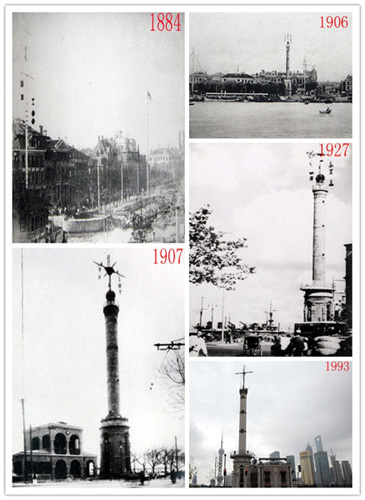
The development of Shanghai signal Tower.
This year is the 140th anniversary of the establishment of the Xujiahui Observatory. On November 12, the China Meteorological Administration (CMA) and Meteo-France will jointly held an International Symposium on Progress in Meteorological Science and Technology and Urban Weather Services. It will demonstrate the important role of meteorological science and technological advances in urban development. The Symposium will take the forms of special and thematic reports, as well as outlook the advanced technology in urban meteorological disasters prevention & mitigation and responding to the climate change. During the period of Symposium, the activities of celebrating the 140th anniversary and reviewing development progress will be held to show the history and culture of meteorological development.
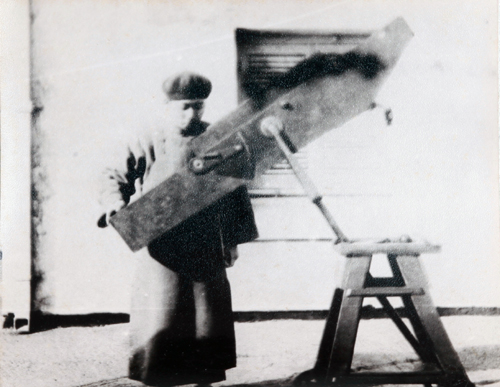
A worker of the Xujiahui Observatory was making an ozone observation. (1902)
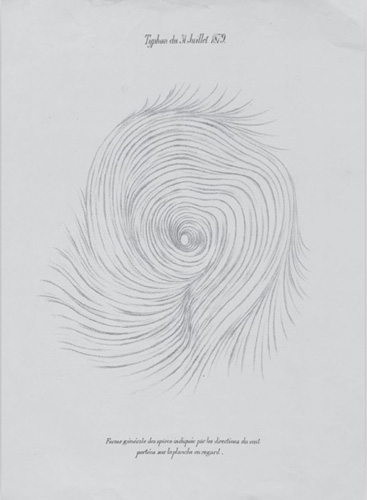
On Jul.31 of 1879, Marscus Dechvrens, the first manager of the Xujiahui Observatory drew a picture of typhoon shape and the location of typhoon eye. The picture's structure is very similar with typhoon image observed by modern satellite.
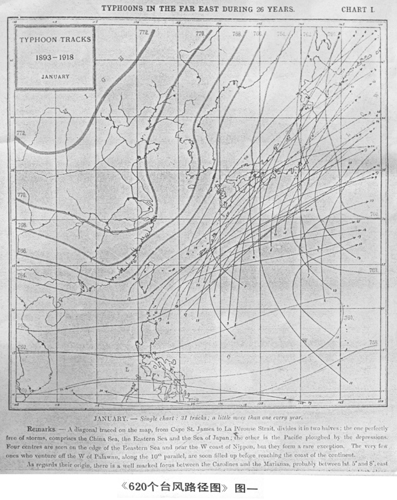
In 1920, R.P.L.Froc, the former director of the Xujiahui Observatory drew a chart set for 620 typhoons' track which passed Shanghai and NW Pacific Ocean in 1893-1918.
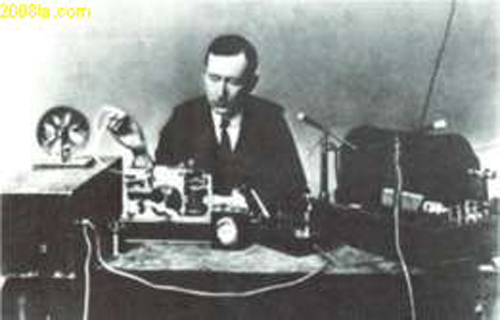
On Mar.1 of 1920, the Xujiahui Observatory began to carry out aviation service and issued upper-air wind conditions two times a day.
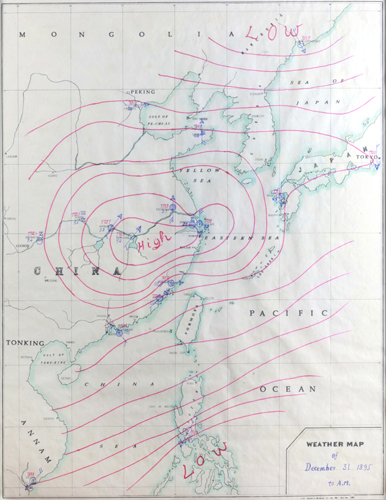
China's first surface weather chart for East Asia.
Editor: Kong Yan and Hao Jing
Celebrations held marking 140th anniversary of Xujiahui observatory

On November 12, an international symposium was held in Shanghai to mark the 140th anniversary of Shanghai Xujiahui observatory.
Attending were WMO Secretary-General Michel Jarraud; CMA Deputy Administrator Shen Xiaonong; Mr. Jiang Ping Deputy Mayor of Shanghai Municipal Government; Mr Jean Pierre Javelle, Director of Archive of Meteo-France; Mr Shun Chi-ming, Director of the Hong Kong Observatory; and Academicians and university professors from China and overseas.
Xujiahui Observatory is one of the earliest institutions that did meteorological work in the world. Its continuous meteorological data is highly valuable for weather forecast and climate change research both for China and world, said Shen Xiaonong in addressing the symposium.
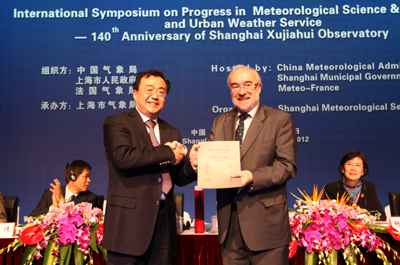
WMO Secretary-General Michel Jarraud presented certificate to Tang Xu, Director-general of Shanghai Meteorological Service to commend their efforts for long term observation.
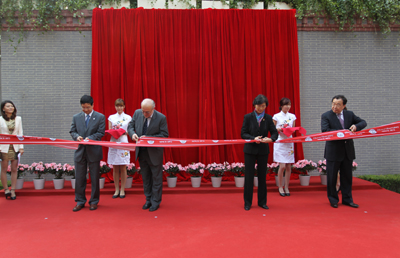
Ribbon cutting ceremony was held to mark the 140 anniversary of the Observatory.
As one of the world’s foremost observatories for the continuous long-term time series of climatological data, the Xujiahui Observatory was established in 1872. The multi-functional observatory issued a typhoon forecast for the 1st time in 1879. In 1895, the 1st surface weather chart for East Asia was produced by the Observatory. Since 20th century, the Observatory has gradually become an integrated research institution, which included meteorological, astronomical, geomagnetic and marine services.
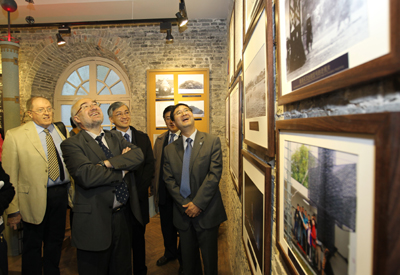
Participants viewed the historical pictures and relics of the observatory.

WMO Secretary-General Michel Jarraud and CMA Deputy Administrator Shen Xiaonong views outreach pictures in Xujiahui Observatory.
The celebration planned for early November are expected to highlight the Observatory’s status in the history of international meteorology, as well as on the importance of 140 years of uninterrupted observations and operations. Such long-term climate data are incredibly valuable in assessing climate variability and climate change, said David Grimes, Assistant Deputy Minister MSC, Environment Canada and President of WMO in his congratulating letter to Dr. Zheng Guoguang, Administrator of CMA.
The Observatory has formally recognized as a Centennial Climate Station by WMO.
At the symposium, participants discussed on the progress in meteorological service, science & technology, and urban weather service.
The symposium was hosted by CMA, Shanghai Municipal Government, Meteo-France and organized by Shanghai Meteorology Service. (Nov. 12)
Reporter He Mengjie
Editor Zhang Yong